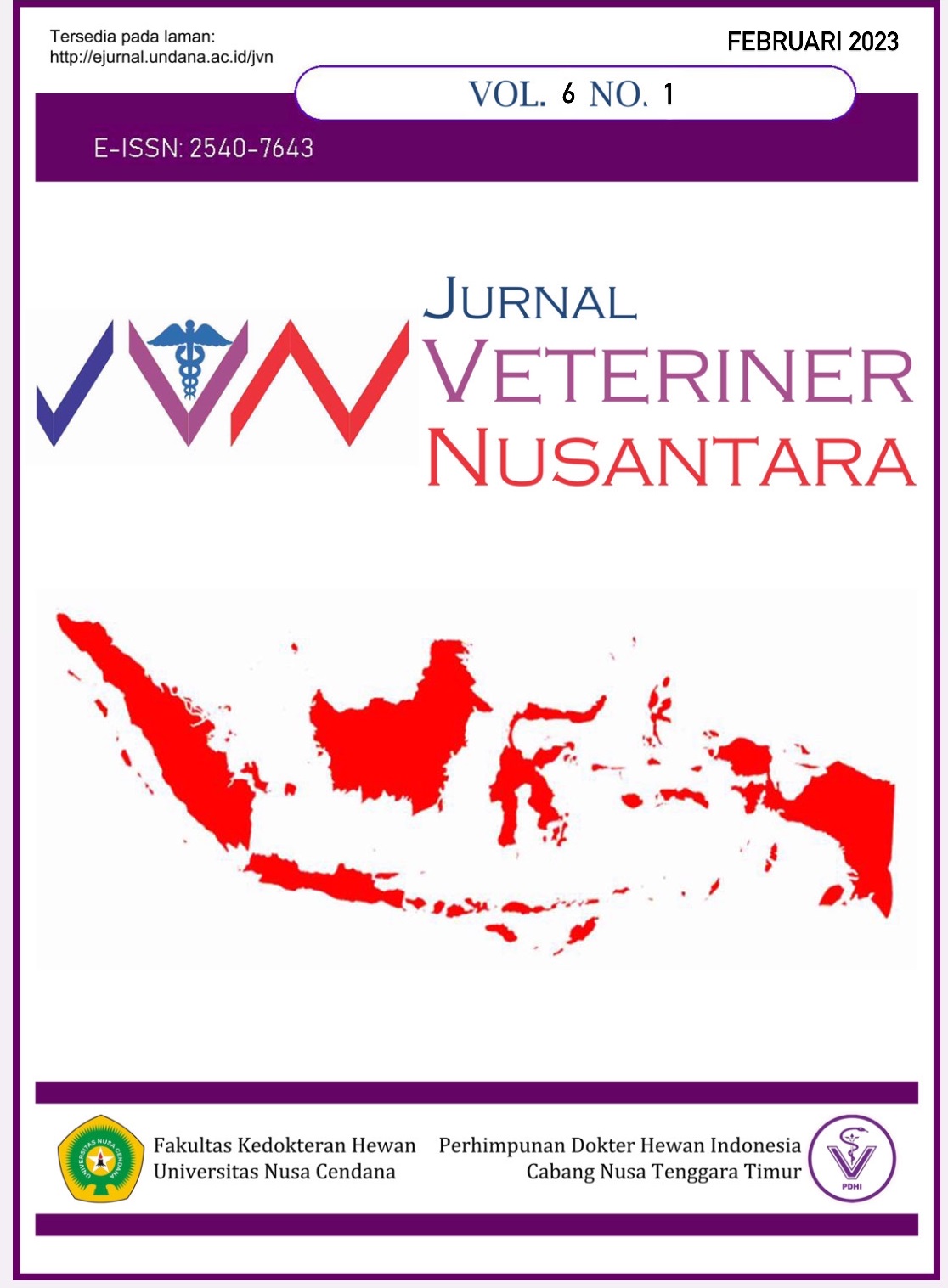Studi Literatur Status Resistensi Aedes sp. Terhadap Larvasida di Indonesia
Abstract
Aedes sp. is the main vector of dengue hemorrhagic fever, which consists of Ae. Aegypti and Ae. albopictus. DHF cases in Indonesia always fluctuate every year, in 2019 there were 138,127 cases and 919 deaths. The population and habitat of the dengue vector is important information in the control and prevention strategy both naturally and chemically by using insecticides. Common insecticides that are often used are divided into 4 groups, namely carbamates, organophosphates, organochlorines, and pyrethroids. The use of insecticides in inappropriate doses for a long time can lead to resistance. This study aims to determine the resistance status of Aedes sp. against insecticides used in Indonesia. This research is a type of library research using a minimum of 50 literatures, preferably those published in the last ten years. The source of the literature is taken based on the relationship or relationship with the title of the literature study that will be studied. The library search was obtained from Google Scholar with the help of the Mendeley application and analyzed descriptively. The results showed that there were 15 types of insecticides from four classes of insecticides that were no longer effective in controlling dengue vectors in Indonesia, such as: Carbamates (bendiocarb 3.45%), Organophosphates (bromophos 1.72%, fention 1.72%, clopyrifos 1.72%, lamdasihalothrin 1.72 %, malation 20.69%, temefos 18.97%), Organochlorines (DDT 1.72%, dieldrin 1.72%), and Pyrethroids (D-alletrin 3.45%, deltamethrin 6.90%, lamdacyhalothrin 3.45%, metofluthrin 1.72%, permethrin 18.97%, cypermethrin 10.34% , transfluthrin 1.72%. Of the 15 species, malation was the most common type of insecticide found, namely 20.69%, followed by temefos and permethrin each with 18.97%.
Downloads
References
Ahmad I, Astari S, Tan M. (2007). Resistance of Aedes aegypti (Diptera: Culicidae) in 2006 to pyrethroid insecticides in Indonesia and its association with oxidase and esterase levels. Pakistan Journal of Biological Sciences, 10(20), 3688–3692.
Alfiah, S. (2011). Dikloro difenil trikloroetan (DDT). Vektora, III (2), 149-156.
Anindita R, Kesetyaningsih TW. (2016). Deteksi resistensi larva aedes aegypti dengan uji biokimia berdasarkan aktivitas enzim esterase di Kabupaten Bantul DIY. Mutiara Medika,7(2), 88-94.
Arief R. (2000). Uji resistensi Aedes aegypti (L.) dari empat kota di Jawa Barat terhadap propoksur, malathion, permethrin, dan esbiothrin (Skripsi ITB, Bandung).
Arasy AA, Nurwidayati A. 2017. Status Resistensi Anopheles barbirotris terhadap Permethrin 0,75% Desa Wawosangula, Kecamatan Puriala, Kabupaten Konawe, Provinsi Sulawesi Tenggara.Jurnal Vektora Penyakit, 11(1): 27-32.
Amarasinghe A, Kuritsky JN, William Letson G dan Margolis HS. (2011). Dengue virus infection in Africa. Emerging Infectious Diseases, 17(8), 1349-1354.
Bangs MJ, Anis BA, Bahang ZA, Hamzah N, Arbani PR. (1993). Insecticide susceptibility status of Anopheles koliensis (Diptera: Culicidae) in Northeastern Irian Jaya, Indonesia. Southeast Asian J. Trop. Med. Public Health, 24(2), 357–356.
Brengues C, Hawkes NJ, Chandre F, McCarroll L, Duchon S, Guillet P, Hemingway J. (2003). Pyrethroid and DDT cross-resistance in aedes aegypti is correlated with novel mutations in the voltage-gated sodium channel gene. Medical and Veterinary Entomology, 17(1), 87-94.
Brahim R, Sitohang V, Zulkarnaen I. (2011) Profil Kesehatan Indonesia 2010. Jakarta: Kementerian Kesehatan Republik Indonesia.
Centters for Disease Control and prevention. 2012. Mosquito lifecycle, viewed 10 February 2018, www.cdc.gov/dengue/entomologyecology/m_lifecycle.html.
Direktorat Jendral Pengendalian Penyakit dan Penyehatan Lingkungan. 2012, Pedoman Penggunaan Insektisida (Pestisida) dalam Pengendalian Vektor, Jakarta, Kementrian Kesehatan Replublik Indonesia.
Ghiffari A, Fatimi H, Anwar C. (2013). Deteksi resistensi insektisida sintetik peritroid terhadap aedes aegypti (L). Strain Palembang menggunakan teknik polymerase chain reaction. Aspirator,5(2), 37-43.
Gubler DJ, (1998). Dengue and dengue hemorrhagic fever. Clinical Microbiology Reviews, 11(3), 480-496.
Hakim L. (2007). Resistensi nyamuk Aedes aegypti terhadap insektisida cypermethrin di daerah endemis DBD Jawa Barat. Inside, II (2).
Husna RN, Wahyuningsih NE dan Murwani R. (2017). Mosquito breeding place and container index are related to dengue hemorrhagic fever cases in uptown Semarang. Advanced Science Letters, 23(7), 6468-6471.
Hamid PH, Ninditya VI, Prastowo J, Haryanto A, Taubert A, Hermosilla C. (2018). Current status of Aedes aegypti insecticide resistance development from Banjarmasin, Kalimantan, Indonesia. BioMed Research International, 2018 (1735358), 1-7. https://doi. org/10.1155/2018/1735358.
Hidayati L. (2016). Status resistensi Aedes aegypti terhadap insektisida dan hubungan iklim dengan kejadian demam berdarah dengue di Kota Sukabumi. Institut Pertanian Bogor.
Ikawati B, Sunaryo, Widiastuti D. (2015). Peta status kerentanan Aedes aegypti (Linn) terhadap insektisida cypermethrin dan melathion di Jawa Tengah. Aspirator, 7(1), 23-28.
[IRAC] Insecticide Resistance Action Committee. 2006. Prevention and Management of Insecticide Resistance in Vectors and Pests of Public Health Importance. Seattle, USA.
[IRAC] Insecticide Resistance Action Committee. Insecticide resistance: Causes and action. Southern IPM Centre. Diakses pada 25 Januari 2015 dari www.sripmc.org/ IRACMOA/IRMFactSheet.pdf.
Istiana, Heriyani F, Isnaini. (2012). Resistance status of Aedes aegypti larvae to temephos in West Banjarmasin. Epidemology and Zoonois Journal, 4(2), 53-58.
Kementrian Kesehatan Republik Indonesia. 2011. Laporan Hasil RISKESDAS Indonesia tahun 2010. Jakarta: Badan Penelitian dan Pengembangan Kesehatan.
Kementerian Kesehatan Republik Indoesia, (2017a). Profil Kesehatan Indonesia. Jakarta.
Kementrian Kesehatan Republik Indonesia. (2019). Profil Kesehatan Indonesia 2018. Jakarta.
Kementrian Kesehatan Republik Indonesia. Direktorat Jendral Pengendalian Penyakit dan Penyehatan Lingkungan. 2020. Pedoman Penggunaan Insektisida (Pestisida) dalam Pengendalian Vektor, Jakarta, Kementrian Kesehatan Republik Indonesia.
Kirnowardoyo S. (1985). Status of Anopheles malaria vectors in Indonesia. The Southeast Asian Jouenal of Tropical Medicine and Public Health, 16(1), 129-132.
Lima JB, da Cunha P, Silva Jr, Galardo A K, Soares S, Braga RP, Ramos DV. 2003. Resistance of Aedes aegypti to Organophosphates Inseveral Municipalities in the State of Riode Janeiro and Espirito Santo,Brazil. Am. J Trop Med Hyg, 68:329–33. Sundari S, Orbayinah S. 2010. Deteksi Resistensi Insektisida Nyamuk Aedes aegypti Berdasarkan Aktivitas Enzim Glutation S-Transferase, Jurnal Mutiara Medika,10(1): 62-67.
Mardihusodo SJ. (1995). Microplate assay alnalysis of potential for organophosphate insecside resistense in Aedes aegypti in the Yogyajarta Municipality, Indonesia berkala ilmu kedokteran, 27(2), 71-79.
Nofita E, Rusdji SR dan Irawati N. (2017). Analysis of indicators entomology Aedes Aegypty in endemic areas of dengue fever in Padang, West Sumatra, Indonesia. International Journal of Mosquito Research, 4(2), 57-59.
Prasetyowati H, Astuti EP, Ruliansyah A. 2016. Penggunaan Insektisida Rumah Tangga dalam Pengendalian Populasi Aedes aegypti di Daerah Endemis Demam Berdarah Dengue (DBD) di Jakarta Timur. Jurnal Aspirator, 8(1): 29 -36.
Santya RNRE, Ipa M, Delia T, Santi M. (2008). Penentuan status resistensi Aedes aegypti dari daerah endemis DBD di Kota Depok terhadap malathion. Buletin Penelitian Kesehatan, 36(2), 20-25.
Soegijanto S. (2006). Demam berdarah dengue. Edisi 2. Surabaya: Airlangga University Press.
Semidi K. 2018. Resistensi Aedes sp. sebagai Vektor Demam Berdarah Dengue (DBD) Terhadap Insektisida Permethrin 0,25 % di Kota Kupang [Skripsi]. Kupang: Universitas Nusa Cendana.
Soerono M, Davidson G, Nuir D. (1965). The development and trend of insecticide-resistance in Anopheles aconitus in Indonesia and its association with oxidase and esterase levels. Bull.Wld.Hlth. Org, 32, 161-168.
Sunaryo, Ikawati B, Rahmawati, Widiastuti D. (2014). Status resistensi vektor demam berdarah dengue Aedes aegypti terhadap malathion 0,8% permethrin 0,25% di Provinsi Jawa Tengah. Jurnal Ekologi Kesehatan, 13(2), 146-152.
Ware D, Whitacre D. (2006). An introduction to insecticides (4th edition). University of Monnesota. Diakses pada 27 Januari 2015 dari http:// ipmworld.umn.edu/chapters/ware.htm.
Wilder-Smith A, Ooi EE, Horstick O dan Wills B, (2019). Dengue. The Lancet, 393(10169), 350-363.
Widiarti, Heriyanto B, Boewono DT, Mujioni, Lasmiati, Yuliadi. (2011). Peta resistensi vektor demam berdarah dengue Aedes aegypti terhadap insektisida kelompok organofosfat, karbamat, dan piretroid di Provinsi Jawa Tengah dan daerah Istimewa Yogyakarta. Buletin Penelitian Kesehatan,39(4), 176-189.
Widjanarko B, Martini, Hestiningsih R. (2017). Resistance status of Aedes sp strain from high land in central Java, Indonesia, as an indicator of increasing vectors capacity of dengue hemorrhagic fever. Annals of Tropicall Midicine and Public Health 10(1) 71.
[WHO] World Health Organization. 2004. Situation of Dengue/Dengue Haemorrhagic Fever In the South-East Asia Region: Prevention And Control Status In SEA Countries. South East Asia Regional Office.
[WHO] World Health Organization. 2009. Dengue: Guidelines for Diagnosis, Treatment, Prevention and Control. New Edition. Geneva, (WHO/HTM/NTD/DEN/2009.1).
[WHO] World Health Organization. 2011. Regional Office for South-East Asia. Comprehensive Guidelines for Prevention and Control of Dengue and Dengue Hemorraghic Fever, WHO.
[WHO] World Health Organization. 2012. Global strategy for dengue prevention and control 2012-2020. Geneva Switzerland.
Copyright (c) 2023 Jefriyono Christian Kandi, Julianty Almet, Nemay A Ndaong

This work is licensed under a Creative Commons Attribution-ShareAlike 4.0 International License.

 Jefriyono Christian Kandi(1*)
Jefriyono Christian Kandi(1*)



 Visit Our G Scholar Profile
Visit Our G Scholar Profile




